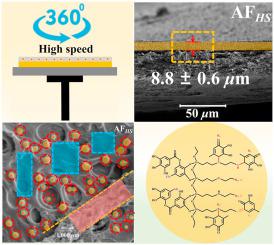Journal of Membrane Science ( IF 9.5 ) Pub Date : 2021-02-09 , DOI: 10.1016/j.memsci.2021.119123 Sun-Jie Xu , Qian Shen , Li-Han Luo , Hai-Zhen Zhang , Jia-Jun Wan , Ping Li , Peng Gao , Yu-Zhe Wu , Yi-Hao Tong , Zhen-Liang Xu , Gui-E Chen

|
Compared with traditional methods for elaborately tailoring the active layer of thin-film composite (TFC) membranes, this study focused on building novel substrates for potential applications in developing organic solvent nanofiltration (OSN) membranes. One kind of “three-parts” hierarchically structured interface with nanospheres and macro surface pores was successfully prepared via Michael addition and Schiff's base (M&S) reactions between N-(2-aminoethyl)-3-aminopropyl triethoxysilane (NAE-A) and glycerite (a natural polyphenol) in the aramid substrate. The thickness was reduced to sub10 μm with the aid of the high-speed spin coating process coupling nonsolvent-induced phase separation (HSSC-co-NIPS) method. The composition characterization results demonstrated the introduction of glycerite, and the reactions occurred in/on the substrate. Scanning electron microscopy (SEM) images clearly showed that the sub10 μm substrate contained a “three-level” hierarchically structured interface that included: (1) a “stalk-like” structure; (2) glycerite-NAE-A silane (GNAS) nanospheres; and (3) the substrate surface. These phenomena also resulted in better surface hydrophilicity. All types of organic solvents, including harsh solvents, such as tetrahydrofuran (THF) and N,N-dimethylformamide (DMF), had stable permeability within the substrate, as did apolar n-hexane and isopar™ G. Therefore, the as-prepared TFC OSN membrane, which had an extremely short polymerization time, retained broad-spectrum solvent stability and had the highest solvent permeance in acetonitrile (24.5 ± 0.4 L m−2 h−1·bar−1). In addition, the resultant TFC membrane almost completely rejected the popular macrolide antibiotic azithromycin (AZM, 748.98 g mol−1) in ethanol, which is used to treat COVID-19.
中文翻译:

SUB10 μ米的大孔芳族聚酰胺基板与有机溶剂纳米过滤分层结构化接口
与精心设计的薄膜复合(TFC)膜活性层的传统方法相比,本研究的重点是为开发在开发有机溶剂纳米过滤(OSN)膜方面的潜在应用的新型基材。成功地制备了一种“三份”与纳米球和宏表面孔隙分层结构化接口经由迈克尔加成和席夫碱(M&S)反应N-(2-氨基乙基)-3-氨基丙基三乙氧基硅烷(NAE-A)和glycerite之间(天然多酚)在芳族聚酰胺基质中。厚度减少至SUB10 μ借助高速旋涂工艺结合非溶剂诱导的相分离(HSSC-co-NIPS)方法。组成表征结果表明引入了甘油,并且反应在底物中/上发生。扫描电子显微镜(SEM)图像清楚地表明,亚10 微米以下的基底包含“三级”分层结构的界面,其中包括:(1)“茎状”结构;(2)甘油-NAE-A硅烷(GNAS)纳米球;(3)基板表面。这些现象还导致更好的表面亲水性。所有类型的有机溶剂(包括苛刻的溶剂,如四氢呋喃(THF)和N,N-二甲基甲酰胺(DMF))在基材内均具有稳定的渗透性,而非极性n-己烷和isopar™G。因此,所制得的TFC OSN膜具有极短的聚合时间,保留了广谱溶剂稳定性,并在乙腈中具有最高的溶剂渗透性(24.5±0.4 L m -2 h -1 ·bar -1)。此外,所得的TFC膜几乎完全拒绝了乙醇中常用的大环内酯类抗生素阿奇霉素(AZM,748.98 g mol -1),后者可用于治疗COVID-19。



























 京公网安备 11010802027423号
京公网安备 11010802027423号